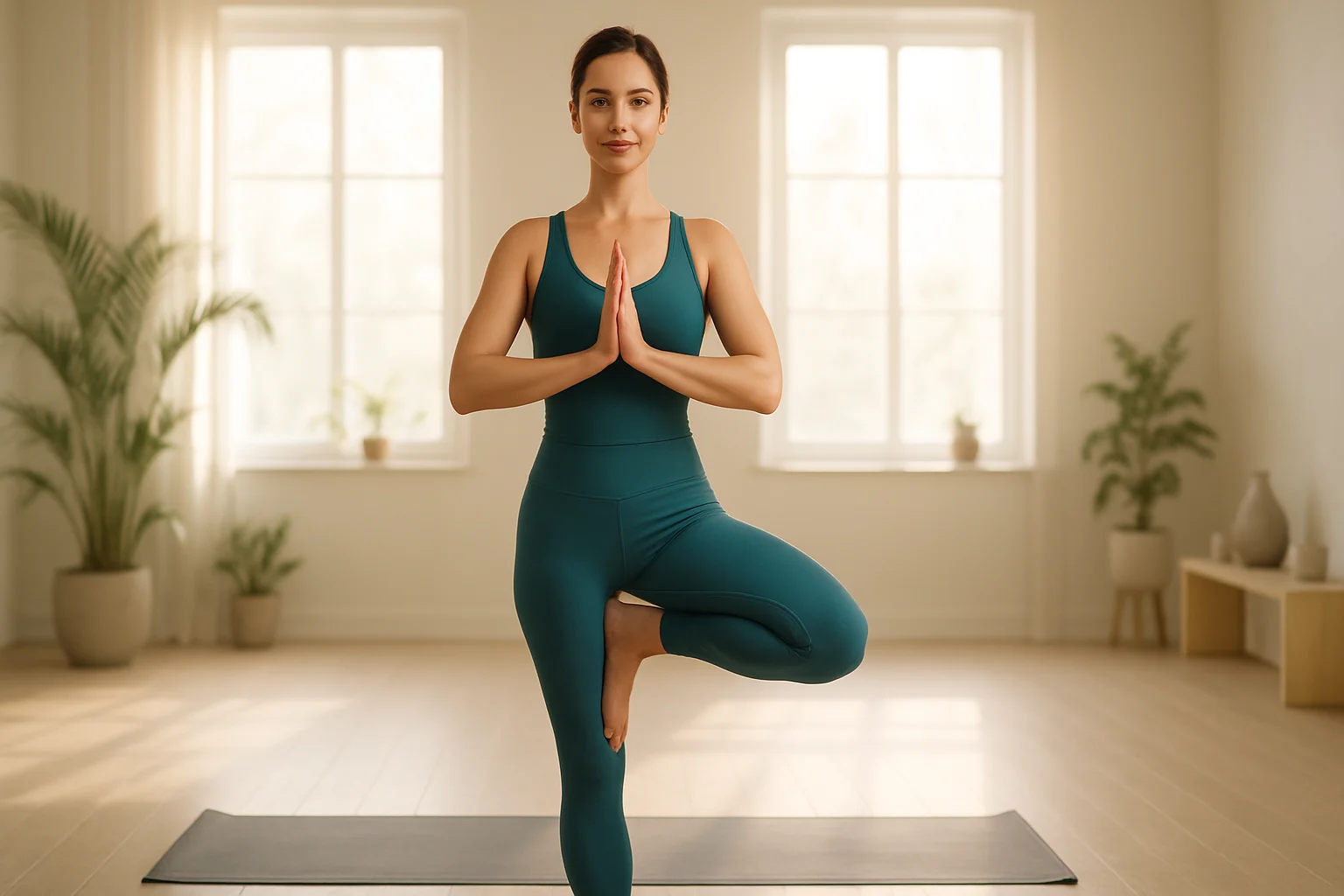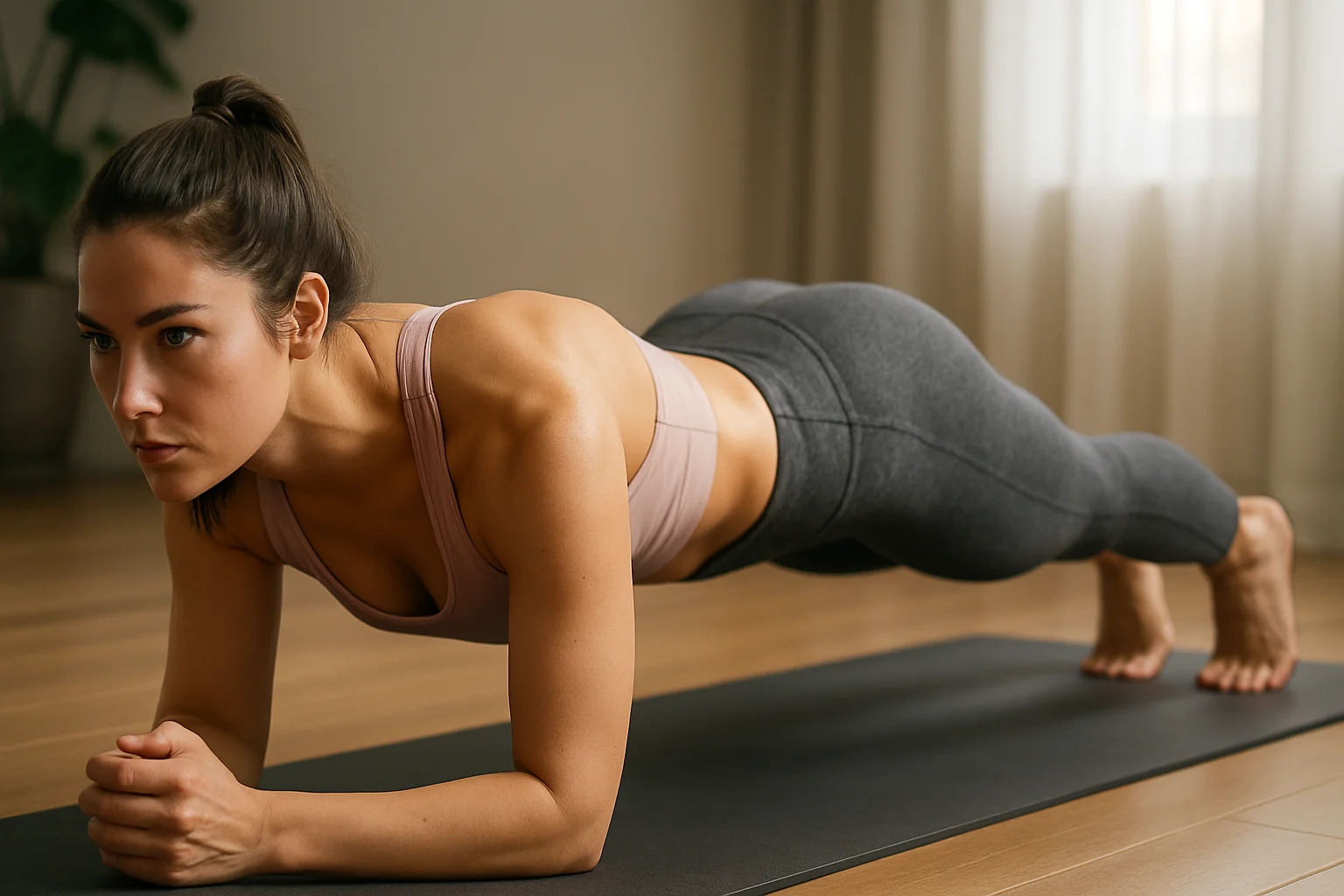
Ready to power up your core? A strong core goes beyond just abs—it’s the key to better posture, may help ease back discomfort, and moving with ease. For women, this yoga sequence for core strength brings balance, confidence, and flow to everyday movement. Picture yourself standing taller, moving through daily tasks with more ease, and feeling steadier in every flow.
Whether you’re new to yoga or have years on the mat, you’ll find options that meet you where you are. Roll out your mat and give it a try today. For a broader look at getting started, check out yoga flexibility guide.
Table of Contents
- Key Takeaways for This Core Flow
- Why This Core Flow Matters for Women
- Understanding Your Core: Beyond Just Abs
- Core Strength for Women: Unique Benefits
- Safety Tips for Your Yoga Sequence
- Get Ready: Setup & Warm-Up
- Step-by-Step Core Flow
- What to Expect
- Practice Rhythm & Habits
- Core in Daily Life
- Your Core Strength Tracker
- Frequently Asked Questions About Yoga for Core Strength
- Conclusion: Empower Your Core Today
Key Takeaways: Yoga Sequence for Core Strength
- Your core is your body’s powerhouse—it supports your spine, helps your posture, and steadies you in yoga and daily life.
- This sequence meets you at your level, with beginner-friendly options and ways to dial up the challenge.
- Consistency matters: practice 3–4 times a week and you’ll start to notice steadier balance and more strength.
- A stronger core is more than abs—it brings in the deep abdominals, obliques, and back muscles for all-around support.
Why a Yoga Sequence for Core Strength Matters for Women
When you think of core strength, you might picture a six-pack. However, your core is like a natural corset, wrapping around your midsection to stabilize your spine. For women, a strong core supports everything from daily tasks to yoga poses. It may help ease back discomfort, which I’ve tackled using poses from this yoga for lower back pain relief guide. Here’s why it’s essential:
- Better Posture: A strong core counters slouching from desk jobs, reducing spinal strain.
- Improved balance: Your core keeps you steady—whether you’re in Tree Pose or walking on uneven ground.
- Easier daily movements: Lifting a bag of groceries or tying your shoes becomes smoother.
- Enhanced yoga performance: A strong core powers transitions, arm balances, and flowing sequences.
Pro tip: Want to deepen your practice? Explore Yoga Journal’s Yoga Sequences for Women’s Health for ideas to support strength and well-being.
- Transverse Abdominis (TVA): Your deepest abdominal muscle, acting like a stabilizing belt. You can cue it by gently drawing your belly button toward your spine.
- Obliques: Side muscles that help you twist and bend sideways.
- Rectus Abdominis: The “six-pack” muscle, used in spinal flexion (like crunches).
- Erector Spinae: Back muscles along your spine for extension and rotation.
- Pelvic Floor: Base muscles supporting organs and core stability.
By focusing on all these muscles, this sequence builds balanced, functional power. Many of these are classic core yoga poses that target stability and endurance.

Core Strength for Women: Unique Benefits
A strong core is a total game-changer for women. During pregnancy, it can support your changing body and may reduce back strain. After childbirth, it may help you recover pelvic support. In menopause, balance work may help lower fall risk. Plus, a solid core gives you the confidence to nail poses like Crow, moving with grace and ease. This sequence is designed with modifications to fit every stage of your journey.
Safety Tips for Your Yoga Sequence
Before you begin, keep safety first to take care of yourself:
- Go Easy: If anything goes beyond a gentle stretch, ease off or adjust the pose.
- Know Your Limits: Skip Boat Pose or Low Boat if you have lower back issues. Check with your doctor if you have severe back pain or are pregnant.
- Use Props: Grab blocks or blankets to help with alignment and avoid strain.
- Warm Up: Start with gentle movements to prep your body for the practice.
This post has affiliate links. We may earn a commission. Learn more.
Get Ready: Setup & Warm-Up
First, set yourself up for success. If you’re practicing at home, you can follow tips from this no-equipment yoga at home routine to make the most of your space:
- Find a Quiet Space: Choose a distraction-free area.
- Gather Props: A yoga mat is essential; a block or blanket can help with modifications.
- Warm Up: Spend 2-3 minutes in Cat-Cow to mobilize your spine.
- Connect with Breath: Use deep, steady breaths (try Ujjayi breath) to engage your core.
- Set an Intention: Focus on “building strength” or “feeling grounded.”
The Ultimate Yoga Sequence for Core Strength
This yoga core workout builds power progressively. Take it slow, matching each breath with your movement so the flow feels natural. These core yoga poses help build stability without relying on momentum. Here’s a quick overview:
| Pose Name | Core Focus | Difficulty | Hold Time |
|---|---|---|---|
| Tabletop Core Engagement | Transverse Abdominis | Beginner | 5-8 breaths |
| Bird-Dog Pose | Core Stability, Glutes | Beginner | 3-5 breaths/side |
| Plank Pose | Entire Core | Intermediate | 30 sec-1 min |
| Side Plank | Obliques | Intermediate | 20-30 sec/side |
| Dolphin Pose | Deep Core, Shoulders | Intermediate | 5-8 breaths |
| Boat Pose | Rectus Abdominis | Intermediate | 5-10 breaths |
| Low Boat | Lower Abs | Advanced | 15-30 sec |
| Supine Leg Lifts | Lower Abs | Intermediate | 8-10 reps/leg |
| Wind-Relieving Pose | Relaxation | Beginner | 5-10 breaths |
| Supine Spinal Twist | Obliques, Spine | Beginner | 5-10 breaths/side |
| Savasana | Relaxation | Beginner | 5-10 min |
1. Tabletop Core Engagement for Core Strength
Start on hands and knees, wrists under shoulders, knees under hips. Keep your back flat. As you exhale, draw your belly button toward your spine without rounding your back. Inhale to relax slightly. Repeat 5-8 times.
Core Focus: Engages the transverse abdominis, building foundational stability.
Advanced Tip: Hold the engagement for a full breath cycle to deepen the work.
2. Bird-Dog Pose for Core Stability Yoga
From Tabletop, inhale and extend your right arm forward, thumb up. Exhale, extend your left leg back, toes down. Keep hips level. Hold for 3-5 breaths, then switch sides. This is a great entry point for core stability yoga, teaching your body to hold balance with ease.
- Modifications: Extend one limb at a time or keep toes on the ground.
- Core Focus: Stabilizes spine and strengthens glutes.
Pro tip: Imagine a glass of water resting on your lower back to keep your hips steady.
3. Plank Pose for Core Strength
From Tabletop, step feet back to form a straight line from head to heels. Hands are under shoulders, fingers spread. Hold for 30 seconds to 1 minute, moving mindfully with steady breath.
- Modifications: Lower knees to the mat or try Forearm Plank.
- Core Focus: Engages entire core, shoulders, and legs.
4. Side Plank for Oblique Strength
From Plank, shift weight to your right hand and outer right foot. Stack left foot on top, lift left arm. Hold for 20-30 seconds per side.
- Modifications: Lower right knee or place top foot in front.
- Core Focus: Targets obliques and shoulder stability.
5. Dolphin Pose for Deep Core Work
From forearms and knees, tuck toes and lift hips into an inverted V. Press forearms into the mat. Hold for 5-8 breaths.
- Modifications: Bend knees slightly if hamstrings are tight.
- Core Focus: Strengthens deep core and shoulders.
6. Boat Pose for Core Strength
Sit with knees bent, feet flat. Lean back, lift feet until shins are parallel to the floor, arms forward. Hold for 5-10 breaths.
- Modifications: Hold thighs, keep toes on the floor, or lift one leg.
- Core Focus: Targets rectus abdominis and hip flexors.
7. Low Boat for Lower Abs
From Boat Pose, lower shoulders, head, and feet a few inches off the ground, keeping lower back pressed into the mat. Hold for 15-30 seconds.
- Modifications: Keep knees bent or lift only head and shoulders.
- Core Focus: Intensifies lower abdominal strength.
8. Supine Leg Lifts for Core Strength
Lie on your back and slide your hands under your lower back. Gently tilt your pelvis so your low back meets the mat. Lift one leg, then lower it with control without letting your back arch. Repeat 8–10 times per leg.
- Advanced: Lower both legs together; stop as soon as your low back starts to lift.
- Core Focus: Targets the lower abs while maintaining pelvic stability.
9. Wind-Relieving Pose for Relaxation
Lie on your back and hug both knees to your chest. Rock slowly side to side. Stay for 5–10 easy breaths.
Core Focus: Helps release tension through the core and lower back.
10. Supine Spinal Twist for Obliques
Extend left leg, cross right knee over to the left, extend right arm out. Gaze right or up. Hold for 5-10 breaths per side.
Core Focus: Stretches obliques and improves spinal mobility.
11. Savasana for Integration
Lie flat, legs slightly apart, arms by sides, palms up. Relax completely for 5-10 minutes.
Core Focus: Integrates benefits of the practice.
What to Expect from Your Yoga Sequence
After about 4 weeks of practicing this abdominal yoga workout 3-4 times weekly, many people notice better balance in standing poses, easier daily movements, and improved posture. For example, holding Plank Pose may feel more accessible, and lifting groceries becomes smoother. Additionally, some people report less lower back discomfort as core support improves. Stay consistent and celebrate small wins!
Consistency: Your Abdominal Yoga Workout Plan
Core strength grows with steady practice. Aim for this yoga core sequence 3–4 times a week. Stay consistent and this abdominal yoga workout can build strength without any heavy gear. On busy days, pick 3–4 poses and hold them a bit longer. Even ten focused minutes moves the needle.
Integrating Core Work into Daily Life
Your core isn’t just for yoga. Try these tips to stay engaged daily:
- Sit tall: At your desk, imagine a string lifting the crown of your head and lightly engage your lower abs.
- Walk mindfully: Draw your navel in slightly as you walk to support your posture.
- Lift smart: Brace your core before you lift and let your legs do most of the work.
- Breathe deeply: Try belly breathing—lightly engage your core as you exhale.
Your Core Strength Tracker
Track Your Core Strength Progress
Select your current core strength level to see your progress and get tips!
Frequently Asked Questions About Yoga for Core Strength
Conclusion: Empower Your Core Today
Building a stronger core through this yoga-inspired core workout can change how you move and feel. For women, it’s about more than aesthetics—it’s about confidence, stability, and resilience. My own journey with yoga turned years of slouching into confident posture, and I know you can do it too! To enhance your practice, try mindfulness techniques for stress to stay calm and focused. Roll out your mat and start today—you’ve got this! ✨🧘♀️


